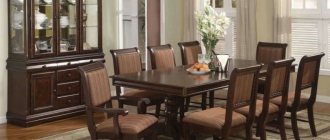join the discussion
Share with your friends
Small kitchens, features of some interior solutions or living in communal apartments - all these situations may require placing a refrigerator in the hallway. You should not be afraid of such a step; the main thing is to calculate the dimensions of the equipment and the available space in the corridor. At the same time, you should not clutter the hallway or place the refrigerator in an inconvenient place, because nothing should interfere with the movement of people and the arrangement of things.
Refrigerator location
Due to the limited number of places where you can put a refrigerator, sometimes a situation arises that it is difficult to place it in the kitchen or room. Therefore, it is often necessary to install the unit in the corridor, and this brings with it both positive and negative aspects.
Pros:
- freeing up space in the kitchen or room;
- unusual design solutions and the opportunity to apply more creative ideas that would not fit into the style of the kitchen;
- less contamination of the refrigerator due to the fact that food is prepared away from the device, and there will be fewer stains on it;
- no need to carry purchased groceries to the kitchen or room, because everything can be laid out at the entrance to the apartment.
Minuses:
- the process of cleaning the device will be more difficult, because you will have to go to the kitchen or bathroom to get water and the necessary cleaning products;
- cooking may become less convenient, because you will have to first transfer all the products from the refrigerator to the kitchen or you will need to go for them several times;
- a clutter of things and equipment in the hallway, which significantly reduces free space.
Despite all the shortcomings, a creative approach can turn an unusual solution for placing equipment in the hallway into something original.
However, before you move on to realizing your plans, you should familiarize yourself with the possible options for placing the refrigerator in the hallway.
Installing a refrigeration unit on a glazed loggia: what does this mean for the owner?
Many believe that a glazed loggia is a solution to the problem in the summer, and it is quite possible to install a refrigerator there.
Let's try to debunk this myth. Have you gone out on a sunny day in the summer to a glassed-in loggia with the windows closed? If yes, then without explanation you will understand that the temperature there is much higher than the permitted +40˚С. And here we return again to the question of the stove next to the refrigeration unit or whether it is possible to put warm soup in the refrigerator. The effect will be almost the same, and sealing rubber bands with magnets that have dried out from sunlight will add to the problems. Operating a refrigerator on an unheated loggia in winter is completely impossible
Location options
- A corridor opening or some kind of niche - the features of the corridor can be an excellent option for placing a refrigerator. This also includes the location of the cabinets in the hallway into which the device will fit.
- A pantry is a convenient option in which the refrigerator will not interfere and the pantry will be used frequently. But there is also a drawback - it opens several doors and increases the time when accessing the device.
- A special custom-made cabinet protects the refrigerator from shocks and unwanted influences, makes the device more stylish and allows it to fit into any interior.
- In the corner of the hallway - an excellent option if the refrigerator fits clearly into this corner.
Sometimes narrower models are specially purchased for such placement.
- In a row with a closet and other furniture in the hallway - an option that is suitable for spacious hallways. It looks stylish and is a fairly practical option.
But the choice of location of the refrigerator depends on a number of factors.
- Practicality . It should be convenient for residents and guests to use both the unit and all the features of the hallway.
- Shape and dimensions of the refrigerator. Depending on the characteristics, it is usually decided whether to fit the device into a closet, place it in an accessible corner or in a row with furniture.
- Corridor capacity. The height of the ceiling, the width of the passage and other characteristics are the main criteria by which it becomes clear whether it is worth moving the unit into the hallway at all.
- Presence of undesirable elements . Heating or frequently used devices and items, sockets or windows should not be located near the refrigerator.
If you have a small kitchen or the long-awaited 5 places
Somewhere, but in the kitchen in the Khrushchev-era building you definitely won’t be able to make circles! And the layout of apartments in new buildings tends to reduce kitchen space.
What can you do for a small kitchen? Here's what:
- 1. If there's absolutely not enough space for a refrigerator, consider whether you can place it in a hallway, closet or room, perhaps mounted in a cabinet, giving it a more room-appropriate look. Pros: an obvious advantage is the solution to the issue of placing the unit, and in some cases this, unfortunately, is the only option that allows you to gain at least some free space for movement.
Cons: if you are not afraid of making circles along the route corridor-kitchen or room-kitchen, then we must remind you that the refrigerator is a rather noisy device. Modern models generally tend to make very strange sounds, but what can we say about older models. Are you ready for these sounds to come to you from the corridor or become part of your room?Another drawback. What do you associate a refrigerator with? That's right, with food, like everyone else. Will it not be an unnecessary reminder about food and a reason, for example, to eat unscheduled between lunch and dinner or to “sin” again and eat too much at night?
- 2. A more radical option may seem to be connecting the kitchen to a balcony or loggia.
This also includes combining a kitchen with a room to create a studio room that is quite popular in modern interiors. Pros: solution to the placement issue; it is possible to reduce the distance between the refrigerator and the kitchen table compared to the previous option. Cons: in the case of a loggia, it would be nice if the refrigerator did not heat up in the sun all day - to avoid this, you can use curtains or blinds on the windows. Keep in mind that all kitchen smells and sounds will be present in your room. In the photo you can see examples of interiors where these recommendations were successfully applied. - 3. Sliding doors to the kitchen.
In some cases, this completely resolves the situation, because you fill the non-functional space. Pros: obvious. Cons: dismantling the door, which is not always possible. - 4. The simplest, but far from budget option, is a non-standard refrigerator size or a wall-mounted version.
A narrow refrigerator can easily fit into a small cabinet; it can also be placed in a shallow niche. The facade of a wall-mounted refrigerator may be no different from the facade of kitchen furniture. And if you do not purchase a ready-made option that suits you externally, you can always decorate it yourself, since there are many quite accessible methods and materials. But the main goal, you see, will be achieved. Pros: obvious. Cons: high prices and possibly a long search for suitable sizes. - 5. Similar solutions to the situation include separate modules for the refrigerator and freezer (for example, there is a mini-freezer 85 cm high), which can be placed under kitchen furniture and work surfaces, designing their façade to match the kitchen furniture.
Pros: obvious. Cons: as in the previous option: it will be expensive and time-consuming to find the perfect size.
We are glad that this article turned out to be informative for you, and even more so - it helped to bring comfort and beauty to the interior of your small or large kitchen.
Small kitchens, features of some interior solutions or living in communal apartments - all these situations may require placing a refrigerator in the hallway. You should not be afraid of such a step; the main thing is to calculate the dimensions of the equipment and the available space in the corridor.
At the same time, you should not clutter the hallway or place the refrigerator in an inconvenient place, because nothing should interfere with the movement of people and the arrangement of things.
Hallway design with appliances
When you plan to install a refrigerator in the hallway, many questions arise. For example, you need to transform the device to match the design of the hallway or vice versa. But professional designers in this case give some advice.
- It is better to adapt the refrigerator to the design of the hallway.
- First of all, it is worth considering the option with built-in equipment. This will significantly save space, and if there are light colors, the space will visually appear even larger.
- For those who place the refrigerator outside the cabinet, it is recommended to build a “window” between the hallway and the kitchen for ease of moving food.
- The unit must be placed so that it does not interfere with normal activities and does not impede access to frequently used things.
- If the hallway is made in a classic style, it is better to use standard models of refrigerators; you can paste them over wood or to match the colors of the corridor.
- For a high-tech style hallway, a refrigerator with a metallic gray touch panel is best suited, and the presence of additional equipment in such a hallway will only be appropriate.
- The height and color of the unit should not stand out from the general style of the interior.
Practical advice
The installation features also depend on the specific model of the device - overheating is most dangerous for “delicate” and “smart” imported equipment. The more powerful the refrigerator, the larger the recommended gap between it and other pieces of furniture. To prevent the product from deteriorating during operation, the serviceability of the electrical wiring is checked in advance, high-quality grounding is carried out, and stabilizers are installed that can prevent damage that inevitably occurs during sudden changes in voltage in the network.
Before installation, it is necessary to check the serviceability of the electrical wiring.
During transportation to its destination, the refrigerator should not shake excessively, which often happens when delivered from afar, on roads with many potholes. It is recommended to secure the product firmly and not remove it from the original packaging, where foam is placed in the right places. After unloading, but before connecting, the item should remain in the room for six to eight hours.
The back of the refrigerator should never touch the wall.
Installation of a refrigerator in a cabinet
To hide the refrigerator in a closet, you should perform a few simple steps.
- It is necessary to select a cabinet of appropriate dimensions for the unit.
- Remove excess shelves and partitions from the closet.
- Make rubber-coated fasteners on the bottom of the cabinet. This is necessary for the refrigerator to stand securely.
- Place the refrigerator in the closet.
The second option is to order a cabinet specifically for the refrigerator.
Both options are great, because in this case there are several positive aspects.
- The unit fits better into the interior of the hallway. This allows for more manipulation of the look because you can now change the cabinet.
- The equipment makes less noise.
- The unit is better protected from damage.
A refrigerator in the hallway can not only fulfill its main tasks, but also complement the interior or bring some originality and even be its highlight. For example, such a technique can be transformed into an art object. To make it fit better into an unusual place, you can choose a color scheme or make the refrigerator brighter. You can cover it with self-adhesive paper or film, stick stickers or a surface on which you can then draw.
For an overview of the wardrobe with a built-in refrigerator in the hallway, see the following video.
Any housewife knows how important it is to have a comfortable kitchen with everything you need for cooking. But, unfortunately, there are such layouts that it is impossible to place all the equipment in a small area. Then many people think about putting a refrigerator in the hallway, while doubting how functional such a solution is. To decide whether this option is suitable, you need to calculate and think about everything.
Forms
Consider the shape of the wardrobe depending on the interior of the hallway, the budget and preferences of the apartment owners. More details about the most current cabinets in the hallway with photo examples will be discussed below.
Corner wardrobe
If there is a free corner in the corridor, you can install a corner cabinet in it. Doors in a straight form will shorten the size of the room, and radius options will add originality.
Rectangular wardrobe
Rectangular cabinets are familiar and liked by most people. They make it much easier to think through the layout of the corridor.
Externally, cabinets can be chosen in a completely different way. Doors can be either with mirrors or classic. However, minimalist patterns are not prohibited. Choose cabinets that span the entire space from floor to ceiling.
Spherical sliding wardrobe
Spherical cabinets are trendy, but not every apartment owner is able to fit them into their interior. Visually, such options are not practical, however, their content includes many advantages.
Spherical cabinets do not take up much space, however, they fit all the necessary things.
How to position
When installing a refrigerator in the hallway, consider the following:
- While working, it gives off heat. Therefore, you cannot place it closer to the wall than 10 cm;
If you decide to place the refrigerator in the hallway, you can choose one of the options:
- Hide it in the closet;
In the closet
If the size of the room allows, you can put a cabinet with a refrigerator inside. This option helps maintain a unified hallway style. This solution turns the unit into invisible, and simple furniture turns out to be a box with a secret.
Miniature models can be conveniently placed in a wide cabinet, which can belong to any style direction - from classic to loft.
When installing in a cabinet, you should consider the issue of ventilation: the equipment should not be allowed to overheat.
Built-in
You can hide equipment in different ways.
- There are special models that require installation in a cabinet. Their outer side has a special fastening system where the facade is installed. This is how the equipment is integrated into the existing furniture ensemble;
Near the wall
Often the size of the room does not allow you to hide the refrigerator. Then it is placed against the wall. Do not forget that the distance to the wall must be at least 10 cm. The handles must not interfere with movement. It is necessary to achieve maximum comfort when opening doors: nothing should limit them.
Technical nuances
Only a highly qualified technician should install built-in equipment!
If the device breaks due to a makeshift installation, repairs under warranty will most likely not be possible. However, even those who will call a technician to your home need to know a number of technical details.
The refrigerator cabinet must be perfectly level and stable.
And most importantly, it must provide the unit with unhindered access of air to cool the heating elements. To do this, it is done:
- Without back wall.
- With holes in the back and side walls.
- With a margin of width and height.
- With a podium for installing a ventilation grille.
It is also important to understand the types of fastening of the facade to the refrigerator door. Built-in appliances have special fastenings on the front surface
Most often there are two types of fastenings - like guides and hinged
Built-in appliances have special fastenings on the front surface. Most often there are two types of fastenings - like guides and hinged.
A mechanism with guides “hangs” the façade on the refrigerator door, and when opened they slide relative to each other. This type of fastening leaves gaps between the doors where debris can accumulate. In addition, the door can only be opened at an angle of up to 90°
. But it is ideal if the cabinet door itself is quite heavy, because... the load is distributed over several places.
The hinge firmly connects one door to another.
There are no gaps with this connection option and the door literally opens wide open. However, hinges are not suitable for a heavy facade (for example, made of solid wood).
Ideally, at the stage of designing a kitchen unit and choosing equipment, you should consult with an installation specialist. A specialist will be able to compare your design desires and the technical capabilities of the refrigerator.
How to disguise
A free-standing refrigerator can be disguised using decorative techniques:
- Paint the same color as the walls;
If you go the opposite way and highlight household appliances, they will become a striking art object. For example, a refrigerator covered with black and yellow police tape with the words “Do not cross” will look fun.
General characteristics and functions
Before moving on to the differences between built-in and conventional technology, let's consider their common basic functions:
- Volume. This is one of the most important parameters. The refrigerator must first fit through all doorways and then hold the right amount of food for the entire family.
- Power. The level of energy consumption and the intensity of cooling of products depends on this. Currently, manufacturers are trying to reduce this indicator by all possible methods, from increasing efficiency through the use of other types of compressors, to improving the thermal insulation properties of the housing. The latter helps keep food cold when the compressor is idle and switched off.
- Freezing method. Over the past 5 years, dry freezing has become the most popular - this technology is called “No frost”. Depending on the manufacturer, the name may sound different, but the essence remains the same. Its main feature is the absence of ice on the products and in the chambers, so such refrigerators do not need to be defrosted. In addition, it is convenient to freeze fruits and vegetables for the winter; according to forecasts, No-Frost will soon simply force competitors out of the market. There are other types of freezing, for example, drip freezing, where drops of condensate flow down the back wall and an ice crust gradually forms.
Ideas for a narrow hallway
There are several tricks that trick our visual perception of width and distance, making a narrow hallway not look cramped.
- If there is absolutely no room for a full-length mirror, you can make the inside of the front door mirrored.
- The direction of laying the floor in a narrow hallway affects the perception of width. Along - increases length. Across - width, but incorrect from a practicality point of view because increases wear of the laminate, overloads the floor with joints. Diagonal laying is something in between.
- If you can refuse doors, refuse them.
- In Khrushchev-era buildings, panel houses and others, the entrance to the bathroom is often located right in the narrow hallway. Consider a sliding door - this can often help you gain extra space.
- A mirror, or better yet, a cut of several small longitudinal mirrors on one wall - and you won’t be able to estimate the width at all.
- A simple white matte smooth ceiling, preferably with hidden light sources. Details about the design of the ceiling in the hallway (beware of sarcasm).
- Glossy surfaces will create an expansion effect similar to mirrors. And glossy furniture in light colors is also more practical than matte.
- Several dim sources of low or hidden light will create shadows. Shadows destroy the perception of space - just what you need in a small area.
Think about functionality, keep it simple and design your furniture correctly. Good luck with the renovation!
Models
The assortment in household appliance stores is huge. To better navigate this diversity, here are a few examples of built-in refrigerators in different price categories.
Atlant XM 4307-000
One of the most popular and inexpensive models of Belarusian production. Two-chamber refrigerator (two doors: refrigerator and freezer), useful area 234 liters. Its height is 178 cm, width – 54. Inside the refrigerator compartment everything is quite simple: 3 glass shelves, a compartment for vegetables/fruits, 4 plastic shelves on the door. Defrosts automatically (drip system).
The freezer has 3 plastic drawers inside and is defrosted manually.
The refrigerator is controlled mechanically. No additional devices or bells and whistles: an egg stand, ice trays - that's the whole set.
For safety, it can stay cold for 16 hours if there is a power outage. The manufacturer provides a 3-year warranty.
According to reviews, this is one of the most acceptable options in its price category. It operates very quietly, which is perfect for a kitchen-living room. There is a positive experience of integrating it into Ikea furniture.
One of the disadvantages that all buyers note is that in order to defrost it, you need to unplug it from the outlet. For built-in technology this is a significant drawback.
According to reviews, this is one of the most acceptable options in its price category. It operates very quietly, which is perfect for a kitchen-living room. There is a positive experience of integrating it into Ikea furniture. One of the disadvantages that all buyers note is that in order to defrost it, you need to unplug it from the outlet. For built-in technology this is a significant drawback.
Beko CBI 7771
Two-chamber refrigerator, country of origin – Türkiye.
In terms of usable area, it is slightly larger than the previous one: 242 liters. Has an antibacterial coating. The refrigerator compartment is equipped with three glass shelves and a “freshness zone”.
Defrosted using a drip system. The freezer with three shelves is equipped with a No Frost system. Height 177 cm. Mechanically controlled. 13 hours of autonomous cold maintenance.
According to customer reviews, this model is quite reliable, but not very spacious - it’s difficult to fit a week’s worth of groceries. Another disadvantage is the lack of an area for storing fruits and vegetables. No Frost in the freezer speaks in favor of the model.
Advantages of built-in units
Built-in devices have a lot of positive aspects. The main advantages of built-in refrigeration cabinets can be indicated as follows:
- Reduced noise levels - during operation, most of the units emit a characteristic hum. Built-in appliances have external panels in the cabinet version, which not only close the unit, but also act as an auxiliary noise suppressor.
- Cost-effective – the walls of the device have additional thermal insulation, which reduces the energy consumption of built-in refrigeration equipment in comparison with free-standing units.
- Versatility - compact parameters allow the unit to be used not only in premises for various purposes, but also in different conditions. For example, built-in refrigerators are a good option for small kitchens.
- Inconspicuous - the unit is virtually invisible against the general background of a kitchen or other room, since its external panels completely coincide with the overall interior design.
Let's sum it up
A refrigerator is a complex device that requires compliance with certain operating rules. All of them are specified in the technical documentation for the household appliance. Only in Russia there is such a problem - “why should I read this, I’ll figure it out this way.” Everyone knows that jokes are born from real cases. There is an interesting example on this topic:
The man opens the instruction manual for the refrigerator and reads the very first line - “Well, dunce, have you broken it yet?”
To prevent similar situations from happening to you, make it a rule to study the technical documentation before connecting the device to the network. This applies to all household appliances. And then, if you follow all the manufacturer’s recommendations, you will be confident that the equipment will serve you faithfully for a long time.
The most reliable winter refrigerator - there are still some of these left in Khrushchev-era buildings The most reliable winter refrigerator - these are still left in Khrushchev-era apartment buildings
We hope that the information presented in today's article was useful to our dear reader. The editors of Tehno.guru tried to convey it as clearly as possible. If you still have questions, you can ask them in the discussions below. We will definitely answer each of them as quickly and completely as possible. We ask you to share your experience - how exactly you placed the refrigerator in a small apartment. This can be done there, in the discussions (photos are welcome). Such information will be useful to those who have not yet encountered a similar problem. Write, ask, communicate, share your experience. Finally, we present to your attention a short but very informative video on today’s topic.











